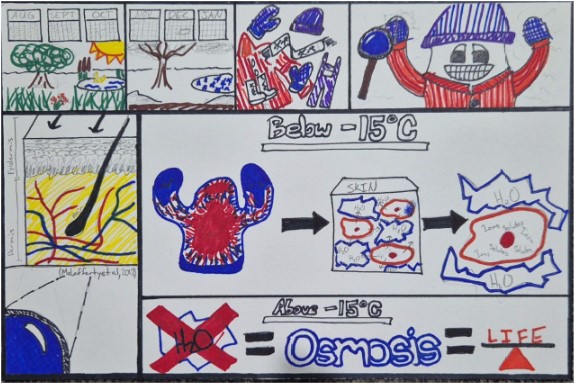Autumn, the season that onsets pumpkin spice lattes, cinnamon candles, and comfy sweaters. It also is the first wakeup call for the frigid temperatures to come, some as mild as just below freezing or the extreme deep freezes where everything goes still. It is vital in such harsh conditions to be properly clothed to protect oneself from cold weather injuries like frostbite. However, through all of the layers the most important one is actually a part of the integumentary system, your skin. This project aids in diving a bit deeper into two of unit seven’s objectives in order to describe the effects of frostbite on the integumentary system. Primarily focusing on the objective “describe the functions of the integumentary” with a secondary focus on, “describe tissues in the integumentary and their functions”. Doing so by simply defining some key concepts of how the body is defending itself against the extreme cold, and what is happening that allows the effects of frostbite.
As we all know, the integumentary system is composed of the skin, hair, nails, sweat glands, and sebaceous glands. In the realm of extreme cold the skin’s primary functions are what provide us the most protection and ability to regulate our temperatures. The skin is composed of two layers, the epidermis and dermis. The epidermis is composed of stratified squamous epithelium and is the fortifying protective layer. While just below is the dermis that is composed of glands and nerve endings that assist in supporting the epidermis and providing feedback to our brains in order to carry out certain functions to maintain homeostasis. For example, when the body becomes too cold it will attempt to mitigate heat loss by reducing the flow of blood to the extremities in order to maintain the warm blood supply at the body’s core for vital organs (McLafferty & Farley, 2012). According to Persitz et al. in Frostbite of the extremities – recognition, evaluation and treatment, dermal blood flow will decrease up to ten times in response to the cold, hence why your hands and feet will be cold while your torso still radiates heat. During the intervals of vasoconstriction eventually the heat loss to the tissue will exceed its threshold and direct cellular damage will occur to the membrane. Due to a disturbance in the cell membrane’s osmotic process, extracellular ice crystals will form causing cellular dehydration eventually progressing to cell lysis (Persitz et al., 2022). The damage continues further with solute injury on top of cell membrane damage, due to dehydration the excess solutes start to build-up which inhibits the Na +-K + pumps resulting in inflammation. Overall, creating a repetitive deteriorating cycle that starts with cellular injury that leads to vascular impairment and inflammation that the tissue cannot self remedy without proper external rewarming (Gupta et al., 2021). However, in temperatures above -15°C yet still below freezing, the skin’s surface membrane is the sole protectant preventing the formation of these ice crystals that kill tissue cells at below freezing temperatures. This is done by the membrane utilizing its permeability to control the dehydration and intracellular freezing that would take place in temperatures any cooler (Mazur, 1970).
Utilizing the comic strip will we be able to visually depict and apply some of these definitions to the process and effects of frostbite on the integumentary system. From the beginning, the first few depictions are meant to set the scene and engage you as the viewer to immerse yourself in the situation. Next, will be the transition to the significance of the skin serving its function as the most important protective layer by zooming into it at the cellular level. Finally, visualizing the aftermath of exposing the skin to extreme cold weather, and what adverse effects there would be if it wasn’t there as a barrier. All in all, the skin of the integumentary system functions as the first line of defense, physically and as a warning method, in order to maintain your body’s homeostasis, especially when faced with the threat of frostbite in extremely cold temperatures.
References
Gupta, A., Soni, R., & Ganguli , M. (2021, April 20). Frostbite – manifestation and mitigation. Burns Open. https://www.sciencedirect.com/science/article/pii/S2468912221000122#b0010
Mazur, P. (1970). Cryobiology: The Freezing of Biological Systems. Science, 168(3934), 939–949. http://www.jstor.org/stable/1729310
McLafferty, E., Hendry, C., & Farley, A. (2012). The integumentary system: anatomy, physiology and function of skin. Nursing Standard (through 2013), 27(3), 35-42. http://uaf.idm.oclc.org/login?url=https://www.proquest.com/scholarly-journals/integumentary-system-anatomy-physiology-function/docview/1081981576/se-2
Persitz, J., Essa, A., Ner, E. B., Assaraf, E., & Avisar, E. (2022). Frostbite of the extremities – recognition, evaluation and treatment. Injury, 53(10), 3088–3093. https://www-sciencedirect-com.uaf.idm.oclc.org/science/article/pii/S0020138322005186


I looked over Mickie Scott’s project and learned about the integumentary system and how it helps protect the human body against the cold. The integumentary system is made up of the skin, hair, nails, sweat glands, and sebaceous glands. The integumentary system is also made up of two layers: the epidermis and dermis. The epidermis is composed of stratified squamous epithelium and is the fortifying protective layer. The dermis is composed of glands and nerve endings that assist in supporting the epidermis and providing feedback to our brains. Mikkie then went on to describe how frostbite occurs in the human body. Typically, the extremities like the fingers and toes will get cold first so the torso and larger organs can stay warmer and avoid failure. Also, Mikkie went on to describe how certain solutes–whether in depletion or excess–can be incredibly damaging to the skin membrane. Mikkie utilized a comic strip to demonstrate how frostbite can happen. This helps show the process and effects of frostbite on the integumentary system. Overall, the project demonstrates that the skin of the integumentary system functions as the first line of defense both physically and as a warning method. This ensures that the body is maintaining homeostasis.